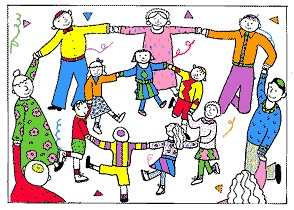Sukkot & Simchat Torah
Sukkot
 Sukkot, a Hebrew word meaning “booths” or “huts,” refers to the Jewish festival of giving thanks for the fall harvest, as well as the commemoration of the forty years of Jewish wandering in the desert after Sinai. Sukkot is celebrated five days after Yom Kippur on the 15th of Tishrei.
Sukkot, a Hebrew word meaning “booths” or “huts,” refers to the Jewish festival of giving thanks for the fall harvest, as well as the commemoration of the forty years of Jewish wandering in the desert after Sinai. Sukkot is celebrated five days after Yom Kippur on the 15th of Tishrei.
One tradition, which takes the commandment to “dwell in booths” literally, is to build a sukkah, a booth or hut, which is decorated with fruits of the harvest. Sukkot is so unreservedly joyful that it is commonly referred to in Jewish prayer and literature as Z’man Simchateinu, the Season of our Rejoicing.
The holiday has both historical and agricultural significance. Historically, Sukkot commemorates the forty-year period during which the children of Israel were wandering in the desert, living in temporary shelters. Agriculturally, Sukkot is a harvest festival and is sometimes referred to as Chag Ha-Asif, the Festival of Ingathering.
Simchat Torah
 Simchat Torah is one of the most joyous holidays in the Jewish calendar and the one that marks the ending of the High Holy Day season. Traditionally, Simchat Torah is considered the Birthday of the Torah, it literally translates to “The Celebration of Torah!” Simchat Torah is a joyous festival where we celebrate Jewish learning, reading, studying and community.
Simchat Torah is one of the most joyous holidays in the Jewish calendar and the one that marks the ending of the High Holy Day season. Traditionally, Simchat Torah is considered the Birthday of the Torah, it literally translates to “The Celebration of Torah!” Simchat Torah is a joyous festival where we celebrate Jewish learning, reading, studying and community.
The Torah is one of the foundations of Judaism and comes to symbolize all Jewish learning (from our youngest to our oldest and everyone in between). Our two Torah scrolls will be taken from the ark, carried and danced around the synagogue with great celebration and music. During the service itself, the concluding section of Deuteronomy, the last book of the Torah, is read, and immediately followed by the reading of the opening section of the first book Genesis, when we read about the creation of the world.
